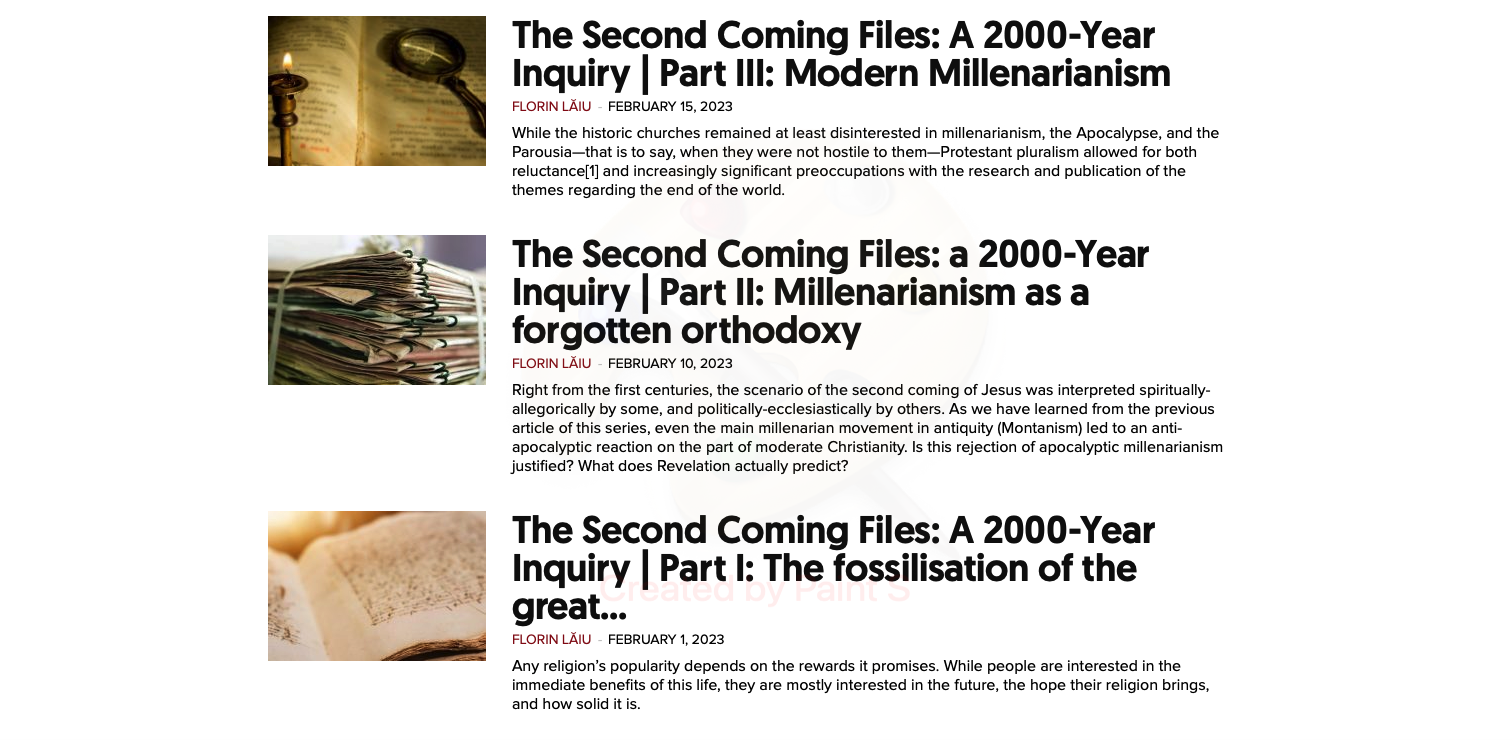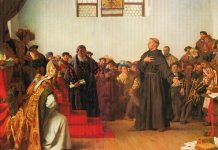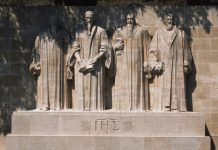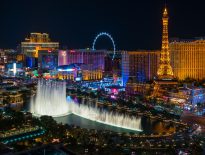In the first three articles in this series, we examined what Scripture says about the coming of Jesus, and also how the biblical books of Daniel and Revelation remain the foundations of understanding time.
The old Orthodoxy has left in writing this unique hope of the Church in the Creed. Unfortunately, however, spiritualism and allegorism caused opposition to millenarianism on the one hand, and on the other hand facilitated the transformation of the Empire into a kingdom of Christ on earth and discouraged biblical millenarianism and the authority of Revelation.
Fortunately, in the 19th century, the millenarian message reached its climax in the history of Christianity. That is why, for a better understanding of the great modern millenarian movements, it is worth studying the cultural context of the 19th century and its historical roots.
The confrontation between enlightened reason and religious obscurantism, which had characterised social-political and cultural institutions in the 18th century, remained in history under the name of the Enlightenment. This century of enlightenment had its roots in the Protestant Reformation and the humanist movement. Although the Enlightenment had its fallacies, it should not be forgotten that this megatrend promoted the pursuit of knowledge and respect for reason. It advocated for the emancipation of people from the totalitarianism of traditional Christian society, which had meant spiritual servitude to the Church and physical (social-economic) enslavement to the feudal state.
Wherever the Church and the great landlords had been masters of the world, the people had been kept in poverty and darkness. For over a millennium, during which it had a privileged position both in the West and in the East, the Church had done almost nothing for the literacy and emancipation of the masses. What is more, the historical Churches were always quick to cut off the momentum of the brave individuals who brought religion too close to the masses and the individual conscience, and who, distrusting the inherited traditions and clerical dogmas, proposed more objective criteria of Christianity, such as Scripture, sound judgement, and moral virtues.
The late effects of the Reformation
In the Age of Enlightenment, Christianity was no longer limited to Catholicism, Orthodoxy, and Protestantism. More radical, more humanistic or nonconformist forms of Protestantism had appeared along with the Lutheran, Reformed, and Anglican churches. Baptist churches first appeared in Europe, including England and its colonies. Pietism, which emerged in Germany and spread to the Russian colonies, kept alive the flame of true Christianity in a spiritually dying and increasingly secularised Church. In England and its colonies, Pietism was called “Methodism” and played a major role in the spiritual education of the public.
Through the emphasis placed on evangelical baptism, the Baptist Church defended the right of each individual to freely choose to be (or not to be) a Christian, thus opening up the possibility of the existence of a modern, free society, in which the Church and the State function in mutual respect, but separately. In traditional churches (Orthodox, Catholic, Old-Protestant), the sacrament of traditional baptism (applied to infants) tends to occupy all the secular space—the Church is one with the nation and is in a marital (or concubinage) relationship with the state. Traditionalism thus encourages, on the one hand, an occasional, “balanced” religiosity, and confessional and political intolerance, on the other. Alternatively, Baptism encouraged, on the one hand, the well-being of the Church and the State as separate entities, and, on the other hand, it promoted the Gospel of the Cross of Jesus as the only hope of salvation, without neglecting piety and Christian virtues.
Methodism, with its vigorous emphasis on the gospel of the progressive Christian experience, the sanctification of life, and the differentiation from the secular individual, defended the underprivileged categories and boosted Christian missionary work a great deal. European pietism also gave an impulse to the preoccupation with education and the underprivileged. Pietists (sometimes called Penitents, Muckers, Stundists, etc.) reinvented family worship and the home church, the Bible study class, and personal concern for prayer and virtuous life. All these new religious movements influenced society in many ways, especially in the Western world.
The revolutions that created the current world
Towards the end of the 18th century, the medieval regime, outdated and unpopular, had to make way for the modern world. First, the American colonies of the British Empire emancipated themselves from the crown between 1775-1791, laying the foundations of an independent liberal and federal state, with a philosophy based in parts on independent Protestant Christianity and principles of humanistic, Masonic, and deistic inspiration. Thus appeared an empire of hope and freedom, without emperors and pontiffs, in which thought and worship (whichever it may be) could develop freely, as long as they did not violate the fundamental laws which defended human rights. Although it was one of the youngest countries in the world, America quickly became the most progressive, developed, and “promising” country in the world—the New World—with an overwhelming influence on humanity over the last two centuries.
In the Old World of Europe, a strong political earthquake with the epicentre in France set the tone and the first impulses of the revolutions of the years 1789-1799, 1830, and 1848. The old Platonic world of sacred rights inherited by birth was sinking. All the crowned scoundrels and all the nostalgics who guarded their privileges at the head of a twice-dead church went on alert, desperately defending their seats. In the 19th century, the Enlightenment gave way to modernism, an increasingly materialistic, secularising, and atheist current. In parallel with modernism and in conflict with it—but also in opposition to the rationalist Enlightenment—appeared romanticism, which was characterised by a certain subjectivism and spiritualism. These megatrends influenced not only philosophy, arts, and politics, but also theology and religion.
The Christian confessional landscape of the New World
The most popular denominations in America in the 19th century were the English Protestants: Anglicans, Episcopalians, Presbyterians (Reformed), Congregationalists, Independents, Baptists, Methodists, as well as other denominations derived from or brought with European immigration. Waves of Catholic immigrants from Ireland and other Catholic countries instilled fear and rejection in the majority Protestant population, which was a Christianity and freedom lover. Violent reactions often arose against newer and more exotic “sects,” or against Masonic lodges, where freethinkers (deists) felt more at home than in church.
As churches sought to expand their influence through practices of more or less fair competition, social reform movements (temperance, anti-slavery, etc) emerged, some of which started from a more liberal environment. Evangelical religious revivals, promoted by preachers in various areas, were a common sight. Patriotism tended to erase denominational differences, so that one could speak of a specifically American Christianity. However, the tensions between a more liberal (Northern) Christianity and a more conservative (Southern) one revealed, at least regarding slavery, that the churches had become polarised, with the liberals advocating for freedom and unionism, and the American righteous from the “Bible Belt” campaigning for the continuation of slavery and secessionism. Traditional churches, as institutions, have proven reactionary.
The missionary explosion of the 19th century
Other movements specific to the century were those that created philanthropic, biblical, and missionary societies. While before 1800 there were only a few newly established Bible societies, in the 19th century the development of Protestantism and especially missions among non-Christians in the homeland and on other continents prompted the translation and spread of the Bible into more and more languages. The history of the inauguration of modern evangelical missions is full of moving episodes, in which authentic Christianity was revealed in all its beauty. The English Baptist William Carey (1792) contributed significantly, both theologically and by personal example, to the impetus of mission in non-Christian countries, after the Moravian Brothers had inaugurated the era of missions in 1732. The level of missionary impulse of the 19th century had not been felt since the first Christian centuries.
Various spiritual movements
Outside of the historic or more recent, accepted evangelical churches, various pseudo-religious, para-religious, pseudo-Christian, para-Christian, humanist-secular, or rationalist-Christian movements have had their share of influence on the world, and it is a mistake to say that their influence has been purely evil; any false philosophy is mixed with some very good ideas. (Equally, every righteous faith is not without human error.) In the Anglo-American space, some of these have existed since the 17th-18th centuries or even longer, while others emerged in the 19th century. They rather tarnish the history of righteous Christianity, but just like classical Christianity or modern evangelical currents, they were also persecuted, and left behind martyrs, even in the Protestant space.
Espousing practical Christianity and mysticism (“inner light”) above interest in the Bible and doctrines, “the Friends,” popularly called “Quakers,” asserted themselves as followers of social egalitarianism, gender equality, simplicity and pacifism, anti-slavery and civil liberties. They are the founders of the state of Pennsylvania.
“The United Society of Believers in Christ’s Second Appearing” (“the Shakers”), a more peculiar branch of Quakerism, are known for the belief that the founder of their sect was actually the second appearance (female incarnation) of Christ. They promoted life in colonies, a sort of monastic community, which imposed celibacy, gender segregation and joint work, encouraged emotional and charismatic worship, with dances and speaking in tongues, and discouraged procreation. Despite their heresies and eccentricities, the Shakers also had a positive social role, taking in abandoned children and orphans, and promoting a cult of work, order, and gender equality.
The “Latter Day Saints” (Mormons) emerged around 1830 as an unconventional and strange movement, with pseudo-charismatic, sacramentalist, and spiritualist-universalist conceptions and practices, combining an outdated patriarchalism (polygamy) with a specific type of apostolicism. Despite the disturbances caused initially, many of which were caused by the vigorous intolerance of the righteous Protestants, the Mormons officially renounced polygamy. They promote family life, healthy lifestyle, civilization, culture, and art. They established settlements that became the foundation of the state of Utah.
The Unitarians, a product of rationalist humanism and the radical Reformation, distinguished themselves by a greater emphasis on reason, slipping into rationalist heresies (such as the rebuttal of the dogma of the Trinity, the divinity of Jesus and the Holy Spirit, and substitutionary atonement, and the statement that human nature is not fallen), or simply reaching a more rational reading of the Bible and rejecting the dogmas about the immortality of the soul, eternal torments, and predestination, considering them irrational, unbiblical, and unworthy of the character of a just God.
Originally from Europe, where they found tolerance in Transylvania, the Unitarians influenced the American religious environment, both positively and negatively. They emphasised reason and morality, the exemplary life of Jesus, and the power of the will, and promoted a realist-critical doctrine of the inspiration of the Bible, asserting that the inspired authors were subject to error, thus assuming the authority of reason above the Bible. They were the first promoters of theological liberalism and were influential both in the Anglican environment and in other denominations, and had well-known representatives in politics and culture. Over time, the Unitarians became more and more universalist and pluralist, a society in which atheists also fit in very well, which seems wonderful—but surely this is no longer a Church!
Read the previous articles of this series:
The place of Freemasons in the picture
The Freemasons (the Masons), the “free builders” of an ideal of fraternity and progress, greatly influenced the 19th century on both sides of the Atlantic. The Masons are not a universal church or religion, but a network of esoteric clubs, characterised by secrecy and a preference for male exclusivity, with symbols and traditions inherited from medieval craft guilds, some chivalric orders, and various legendary Christian and non-Christian traditions. There is no overarching governing body that presides worldwide, there are only regional lodges (associations, clubs) that may or may not accept each other, quite diverse in doctrine and practice.
Freemasonry is an elitist universal brotherhood that promotes personal spiritual growth, knowledge, social charity, religious respect and tolerance, and other idealistic principles, where both Christians and non-Christians find their social-spiritual framework. It has proven to be a support for democracy and individual rights. Many opinion leaders and prominent personalities have been and are Freemasons, and the influence of Freemasonry is at the basis of modern society, even though the lodges do not display political aims. Being so diverse, Masons are guilty of many wrongdoings, done in a more or less discrete manner. However, the relatively closed nature of their society, and nationalist and fundamentalist hysteria, gave rise to all kinds of speculations, from which mountains of scandal sheets emerged, describing the Freemasons as a global satanic conspiracy that sought the installation of a world government or a new world order, which would destroy all sacred local traditions.
Although it is difficult to argue that Freemasons caused the modern revolutions of the 18th and 19th centuries, certain thinkers and politicians who influenced the American Revolution were indeed Freemasons and/or Deists. Deism and Freemasonry are also associated with the French Revolution, with the Jacobin club having Masonic ideals and models. Various other spiritual or conspiratorial societies were built according to the Masonic model, but without being part of Freemasonry (the Rosicrucians, the Illuminati, the Eteria, the Carbonari, the Young Turks, etc). The Revolutions of 1848 were led by personalities educated in the West and twinned by Masonic ideals. Among the founding fathers of the new American religious movements, several had originally been Freemasons, and some remained Freemasons. There were many Freemasons among the clergy of the churches of the old European tradition, even in the Orthodox East.
This brief overview of the philosophical, political, religious, and esoteric currents was necessary to understand in what kind of world the millenarian revivals of the 19th century would emerge, with whom they were competing and from what environment the followers came.
Florin Lăiu is a former Bible professor at the Theological Seminary of the Adventus University in Romania where he worked for 28 years, specialising in biblical languages, biblical exegesis, apocalyptic and biblical translation. Now retired, he is an Adventist apologetic, poetry and music enthusiast, author of articles and books, husband, father of four, and grandfather of six.




















